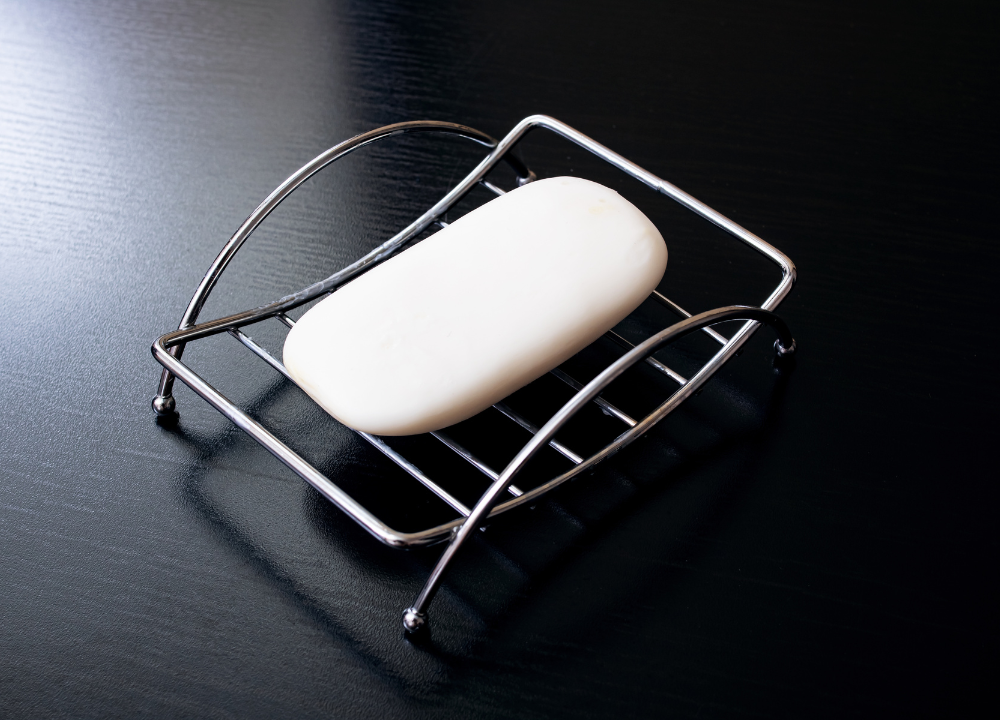To select the perfect kitchen sink soap tray, consider material durability and design compatibility. Assess size and drainage features to ensure functionality and countertop harmony.
Choosing the ideal kitchen sink soap tray begins with understanding your kitchen’s needs and aesthetics. A well-chosen soap tray not only holds your dish soap and sponges but also complements your sink and contributes to the overall kitchen decor. Material is a primary concern; stainless steel, ceramic, and silicone options offer varying degrees of durability and ease of cleaning.
The size of the tray should match your available counter space without hindering daily tasks. Favor trays with effective drainage to prevent water buildup, which can lead to mold and mildew. Ease of maintenance and compatibility with your kitchen’s style are also crucial factors. With the right balance of these elements, your soap tray will blend seamlessly with your kitchen’s functional and stylistic demands, enhancing both the efficiency and the appeal of your cleaning area.
Factors To Consider
Factors to Consider play a pivotal role in selecting the perfect kitchen sink soap tray. They ensure the chosen tray enhances both the aesthetics and practicality of a kitchen space. From its size and design, to the materials used and its functionality, every aspect contributes to its suitability for your home.
Choosing the right size and design of a soap tray can impact your kitchen’s look and ease of use. Consider the following:
- Space available: Measure the area beside your sink to determine the maximum tray size you can accommodate.
- Proportion to sink: Select a tray that complements the sink size. A tray too large or small may look out of place.
- Style preference: Modern or traditional, pick a design that matches your kitchen decor to create a coherent look.
The soap tray material influences its durability and maintenance. Weigh these options:
| Material Type | Maintenance | Durability |
|---|---|---|
| Stainless Steel | Easy to clean | Highly durable, rust-resistant |
| Ceramic | Low maintenance | Likely to crack if dropped |
| Plastic | Simple clean-up | Less sturdy, prone to discoloration |
Functionality dictates a soap tray’s convenience and efficiency. Look for features such as:
- Drainage system: A tray with proper drainage keeps soap dry and extends its lifespan.
- Slip-resistant: A non-slip base ensures the tray stays in place during use.
- Easy to clean: Soap trays that are simple to wash promote better hygiene and require less effort to maintain.
Kitchen Countertop Dish Soap Holder
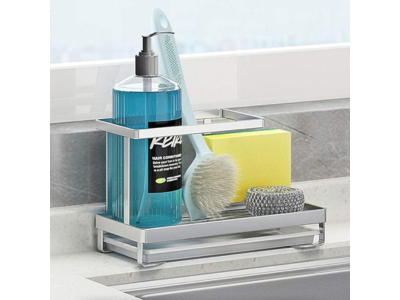
Kitchen Sink Organizer Countertop with Removable Drain Tray
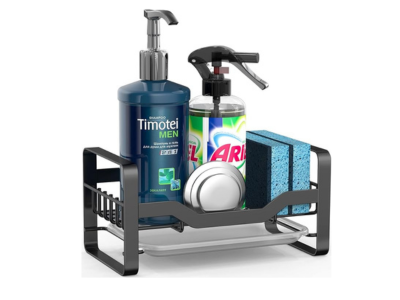
Size And Design
Finding the perfect kitchen sink soap tray involves careful consideration of both size and design. The right fit ensures practicality and enhances kitchen aesthetics. Below are essential guidelines for making the best choice.
Fit And Compatibility
Consider the dimensions of your kitchen sink area before selecting a tray. It should comfortably hold your soap without taking too much space. Measure the length and width of the spot where you plan to place the tray.
Look for adjustable or expandable options if you want flexibility. Ensure the height of the tray allows for easy access to your soap.
Style And Aesthetics
Your soap tray should match the look of your kitchen. Opt for designs that complement your sink’s material and color. Texture and shape also play vital roles in style.
- Consider the color: Choose a tray that matches or contrasts your kitchen’s palette.
- Look at the material: Stainless steel or ceramic trays offer distinct finishes.
Select a design that speaks to your personal taste while being an efficient kitchen accessory.
Material
The heart of any kitchen lies in its functionality, and a crucial aspect of that is tidiness. Choosing the right material for your kitchen sink soap tray not only adds to the aesthetic but also ensures longevity and ease of maintenance. Various materials offer distinct benefits catering to different needs. Whether you prioritize durability, flexibility, or style, there’s a perfect material out there for your soap tray.
Plastic
Plastic soap trays are lightweight and affordable. They come in myriad colors and designs to match your kitchen’s theme. Here are some key points about plastic trays:
- Cheap and cheerful
- Wide color variety
- Prone to scratches over time
- Easy to clean, often dishwasher safe
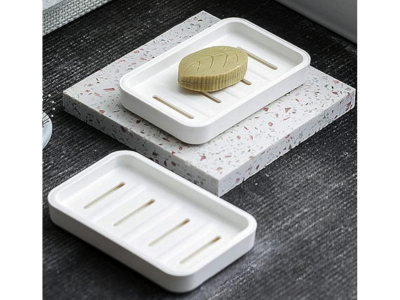
Silicone
Silicone stands out for its flexibility and heat resistance. It’s a non-slip material, keeping your soap in place. Benefits of silicone soap trays include:
- Soft, flexible edges
- Resistant to mold and mildew
- Withstands high temperatures
- Comes in various shapes and sizes
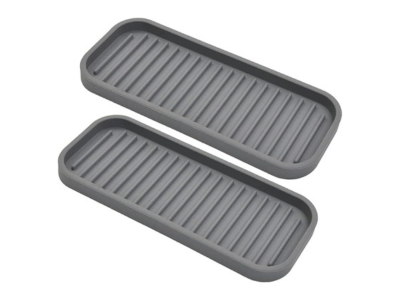
Stainless Steel
Stainless steel soap trays radiate sophistication while boasting durability. They’re perfect for modern kitchens. Consider these advantages:
- Sleek, timeless look
- Resistant to rust and corrosion
- Sturdy and long-lasting
- Easy to wipe clean
Polished Stainless Steel 2-Piece Soap and Sponge Tray
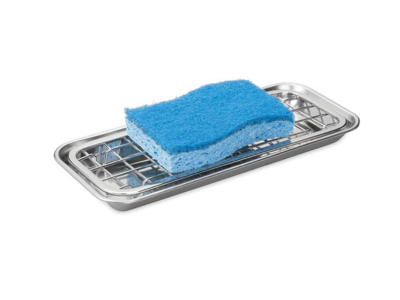
Functionality
Your kitchen sink soap tray is not just a simple accessory. It is a vital tool for maintaining a clean and organized kitchen. Crucial aspects like drainage, ventilation, and stability define a tray’s functionality. Keep reading to find out which features will ensure your soap tray serves you best.
Drainage And Ventilation
Proper drainage and ventilation prevent soap from turning into a mushy mess. Look for a soap tray with slats or holes at the bottom. This design allows water to drain quickly and air to circulate freely. Your soap stays dry and lasts longer.
- Avoid solid trays as they trap water, causing soap to melt.
- Elevated designs lift the soap above standing water.
- Removable bottoms are a plus for easy cleaning.
Grip And Stability
Grip and stability are key to preventing your soap tray from sliding around. A tray with rubber or silicone feet grips the countertop firmly. You won’t have to deal with a tray that moves every time you touch it.
- Non-slip material should be a priority in your choice.
- Weighted trays offer additional stability.
- Compact size ensures the tray fits well in your desired space.
Maintenance And Cleaning
Choosing the perfect kitchen sink soap tray involves more than just design and aesthetics. Maintenance and cleaning are crucial factors that will determine the longevity and hygiene of your soap tray. Let’s dive into what makes for an easy-to-clean, durable, and mold-resistant soap tray.
Ease Of Cleaning
A soap tray should make kitchen clean-up a breeze, not add to your chores. Look for soap trays with smooth surfaces that wipe clean easily.
- Removable parts help you reach every corner.
- Materials like silicone or polished metal don’t hold onto residue.
- Consider trays with a self-draining design to prevent water pooling.
Durability And Resistance To Mold
A soap tray needs to withstand the humid environment of a kitchen. Choose materials that resist wear and tear.
| Material | Features |
|---|---|
| Stainless Steel | Rust-proof, sturdy, and sleek. |
| Ceramic | Easy to clean, but can chip. |
| Plastic | Lightweight and inexpensive, but may discolor. |
Mold resistance is also pivotal. Avoid materials that crack or chip, as these can harbor mold.
- Non-porous materials like glass or silicone are best.
- Regularly air-dry the tray to stop mold growth.
- Consider antimicrobial treatments for added protection.
Frequently Asked Questions
What Factors To Consider When Buying A Soap Tray?
When shopping for a kitchen sink soap tray, consider size, design, material, drainage capabilities, and how it complements your kitchen’s decor. Balance functionality with aesthetic appeal for the best choice.
Are Silicone Soap Trays Better Than Plastic?
Silicone soap trays are often preferred for their durability, flexibility, and resistance to mildew and stains. They provide a modern look and are easier to clean compared to plastic trays.
How Do Soap Tray Materials Impact Longevity?
The material of a soap tray affects its longevity. Stainless steel and ceramic are durable and resist corrosion, while plastic may wear out quicker. Choose a material that withstands frequent use and exposure to water.
Can Soap Trays Prevent Countertop Water Damage?
Yes, soap trays with adequate drainage can prevent water from pooling and damaging countertops. Choose a tray that elevates soap and allows water to drain away quickly to protect surfaces.
Conclusion
Selecting the ideal kitchen sink soap tray need not be a challenge. With a focus on design, material, size, and ease of cleaning, you’ve got the recipe for the perfect sink companion. Remember, the right tray blends functionality with style, elevating your kitchen’s charm.
Happy hunting for that spot-on soap tray!

